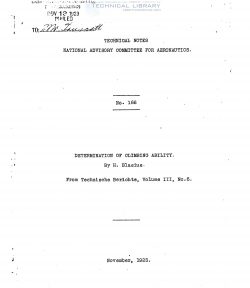naca-tn-166
- Version
- 172 Downloads
- 725.95 KB File Size
- 1 File Count
- November 3, 2016 Create Date
- November 3, 2016 Last Updated
National Advisory Committee for Aeronautics, Technical Notes - Determination of Climbing Ability

The following problem, therefore, has to be solved:- An airplane
has climbed on a certain day under prevailing atmospheric conditions:
as shown by the barograph. How would the same airplane climb in a
standard atmosphere? This problem has already been dealt with bY
Everling (Technisohe Berichte, Volume I, No. 2, p.40, and No. 6,
p.247), using the monthly and yearly mean of the vertical tempera-
ture distribution. Von Mises solved the problem by arithmetical _
methods (Zeitschrift fflr Flugtechnik und Motorluftschiffahrt, 13l7,
p.173). '
In the following discussion, the conditions are examined which
shorten or lengthen the climbing time. In establishing the corrected
barogram, computation seems more practical than graphical treatment.
The Basis of the Answer to the question is summed uprin the
remark that lift, drag, propeller thrust and torque and engine power,
depend only on the density of the air and do not change with the
pressure and temperature, provided the density remains constant-
Accordingly, the rate of climb w = gg, is a function of 7 only
and is, on the other hand, constant for constant W, independently
of p and T. Hence, w, as a function of W, is the true meas-
ure of the rate of climb. Accordingly, the transformation of the
barogram of the day to the standard barogram must be made so that
points of equal density on the two diagrams (Figs. 4 and 5) will be
brought into correspondence for mutual comparison.
Transformation of the Altitudes. For this purpose, it is
necessary to know the vertical temperature gradient, as well as
the barogram of the day, from which the density can be calculated
for each point on the curve. In the standard atmosphere, a given
value of W 'will, in general, be found at a different altitude than
in the atmosphere of the day.
| File | Action |
|---|---|
| naca-tn-166 Determination of Climbing Ability.pdf | Download |
Comment On This Post